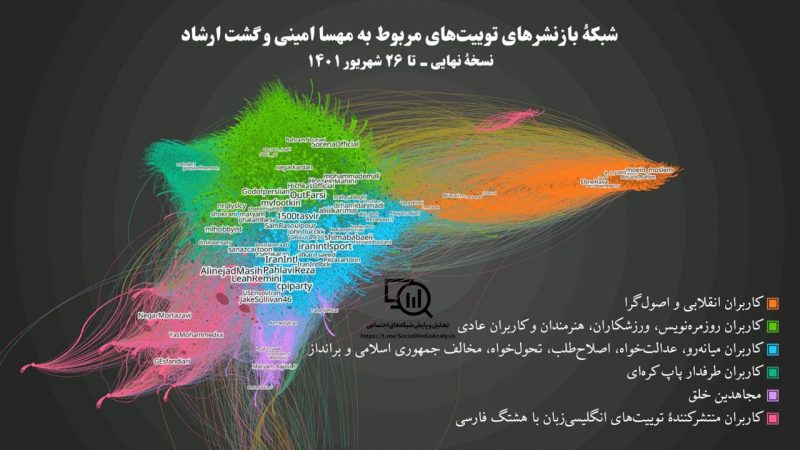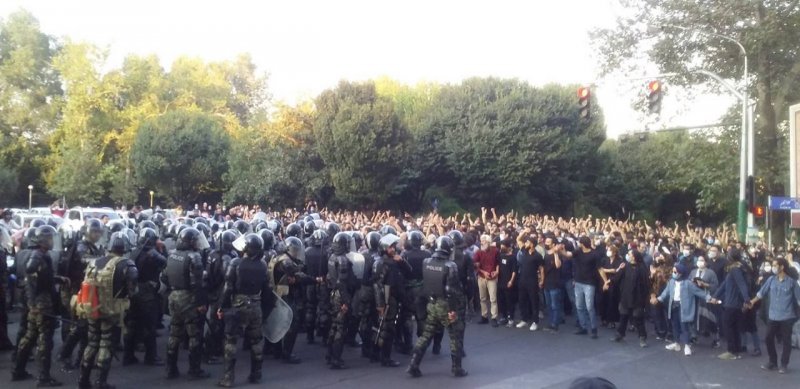Where do the acid attackers’ rumors originate from?
The 7% population supporting compulsory hijab is lonelier than ever
Where do the acid attackers’ rumors originate from? Analyses by Mohammad Rahbari, a data analysis expert and PhD in political sociology, from examining nearly one million tweets and retweets on Twitter show that apart from the value-oriented and revolutionary users who only make up 7% of the entire Twitter network, other Iranians present on Twitter, regardless of their political and social inclinations, oppose the morality police and compulsory hijab. This analysis can be considered as a sample or a statistical representation of all Iranians.
Although, according to this data analyst, this unity among Iranians present on this social network is a rare occurrence on Twitter, it seems to symbolize and represent the unity of Iranians worldwide, regardless of their beliefs and political thoughts.
He elaborated on this issue in a series of tweets, writing that usually, the differences in political inclinations dominate individuals’ online behavior. However, in this case, we see a kind of harmony among various spectrums from justice seekers to opponents of the Islamic Republic, who are willing to retweet each other.
From Vahid Ashtari, the justice seeker, to Mohsen Bayat Zanjani and Mahmoud Sadeghi and Abbas Abdi, the reformists, to Hossein Bastani from BBC and Pouya Zeraati from Manoto network, all are seen in one cluster through an automatic and intelligent categorization, which is unprecedented.
The game is in the hands of the people, not the politicians
Contrary to the main tribunes that are in the hands of the reformist and principlist political streams, and contrary to the perception that the entire media space is seemingly taken over by these two streams, especially the principlist stream, these tweets show that in unofficial media, these two streams are indeed marginalized. What is loud is the voice of the real people, to the extent that it can be said that the main share in the cluster of opponents of the morality police and compulsory hijab is not of political users but of ordinary users, everyday writers, athletes, and artists, with a figure of 40% of the entire network, showing that various segments of the people have unitedly protested this issue.
The People’s Mujahedin of Iran are even fewer than KPOP fans
An interesting and strange point in this analysis is that KPOP fans, or the famous Korean pop group, have a significant presence on Twitter, occupying 6% of the cluster of opponents of the morality police and compulsory hijab, which is noteworthy compared to the People’s Mujahedin of Iran, who have a less than 2% share in this cluster.
According to Mohammad Rahbari, the fact that tweets and retweets by revolutionary and value-oriented users only make up 7% of this network is also a rare phenomenon, as they always constituted more than 10% of the entire network. However, now in this case, they are lonelier than ever. It seems that apart from some of them, especially their cyber army, many revolutionary and principlist figures have decided to at least remain silent in this incident, which in itself is a fortunate event.
Based on the published graph, revolutionary and principlist users are marked in orange on the right side, while others, including everyday users, athletes, artists, and ordinary users, are marked in light green. Moderate users, justice seekers, reformists, transformation seekers, opponents of the Islamic Republic, and overthrowers are marked in blue. Korean pop fans are marked in aqua, the People’s Mujahedin of Iran in purple, and users posting English tweets with Persian hashtags in pink.

What is the rationale of the value-oriented?
Value-oriented individuals who tweet in favor of the morality police and compulsory hijab usually argue that hijab is law and lack of hijab is indecency, so it must be confronted. In the protests, they initially tried to blame everything on the reformists as usual and introduce them as the leaders of the issue. Some security institutions even contacted and threatened certain reformist figures.
They also have a scenario in the virtual space, claiming that those who didn’t protest the murder of Mitra Ostadh are now shedding crocodile tears for the death of Mahsa Amini. They attacked Khatami’s statement and tried to blame the reformist stream for recent events in parliament. However, after seeing that the virtual networks are in the hands of users who are themselves protesters and critics of the reformists, and not only do they not take the reformists’ supportive actions seriously but also make no distinction between them and the principlists in power, they turned to other scenarios.
The acid attackers’ rumor
In recent days, they have used the burning of the Iranian flag, the beating of a chador-wearing woman, and the beating of a police officer as excuses, claiming their patience has run out and there is no room for leniency. Iran, the homeland, the flag, and the chador are our honor and red line. Meanwhile, some users on social media have republished statements by Mesbah Yazdi, the spiritual leader of part of the principlist stream, who said patriotism is shirk.
On the other hand, other images are being republished in the virtual space, showing that the same police officer who was beaten by the people had shot at the people, or another police officer was beating a protesting chador-wearing woman. Some value-oriented accounts on Twitter have spread rumors about the presence of acid attackers among protesters in some cities. One of them even claimed that the acid attackers were seen among the crowd with muscular bodies, military boots, and matching backpacks different from ordinary backpacks, and some of them have been arrested.

